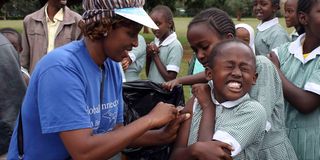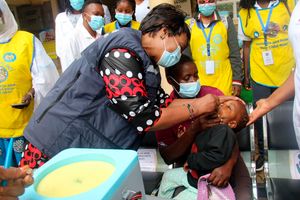Inside Kenya’s immunisation journey

A health worker injects a Measles and Rubella vaccine to a pupil of Moi Nyeri Complex in Nyeri County during the first day of the drive on May 16, 2016
What you need to know:
- The government in June 1980 established the Kenya Expanded Programme on Immunization, which was mandated to oversee and monitor vaccinations to all children in the country against five common diseases at the time.
- To improve outcomes, a number of vaccines have been added since then.
In 1979 when the World Health Organization (WHO) introduced her primary vaccination programme, Kenya adopted it nationally after three years.
WHO's decision was largely fuelled by polio, a highly infectious disease that mostly affects young children and attacks the nervous system, leading to spinal and respiratory paralysis and in some cases death.
“Polio has existed since prehistoric times — ancient Egyptian images show children walking with canes, with withered limbs characteristic of the disease.
“While it affected children around the world for millennia, the first known clinical description of polio by British doctor Michael Underwood was not until 1789, and it was formally recognised as a condition in 1840 by German physician Jakob Heine,” WHO notes.
WHO was set up on April 7, 1948, when its new constitution was then ratified by 26 nations following a period of discussions and consultation after World War II and the formation of the United Nations, of which it formed part. The global health body explains that immunisation is one of the most impactful and cost-effective public health interventions available, averting over four million deaths every year.
“In addition to offering protection from preventable diseases, immunisation also brings children and families into contact with health systems, providing an avenue for the delivery of other basic health services and laying the foundation for primary health care. As such, ensuring universal access to vaccines is a critical entry point for universal health coverage (UHC).”
This is why the government of Kenya in June 1980 established the Kenya Expanded Programme on Immunization (Kepi), which was mandated to oversee and monitor vaccinations to all children in the country against five common diseases at the time.
To improve outcomes, a number of vaccines have been added since then.
The jabs available in all government hospitals include BCG (Bacillus Calmette–Guérin vaccine) which is given at birth, Oral Polio Vaccine (OPV) which is administered at birth, sixth week, 10th week and 14th week, DPT-HepB-Hib(Diphtheria, Pertussis, Tetanus, Hepatitis B and Haemophilus influenzae type B, as a combination of five in one vaccines injection, which is administered at the sixth week, 10th week and 14th week, Pneumococcal vaccine (PCV 10) which is given at sixth week, 10th week and 14th week, Measles Vaccine which is administered at nine months, Yellow Fever Vaccine which is given at nine months, and Tetanus vaccine which is given to pregnant women, women of child bearing age and school children aged seven to 14years.
Vitamin A, though not a vaccine, is a supplement that is given to children at six months,12 months,18 months,24 months,30 months,36 months,42 months,48 months,54 months and 60 months apart from being administered to less than six weeks postpartum mothers.
There are other vital vaccines that are not offered by KEPI but are available in private hospitals and they include Flu Vaccine, which is given at six and seven months, Chicken Pox I & II administered at nine and 11 months Meningococcal conjugate which is given at nine months, MMR – Mumps, Measles and Rubella which is given at 15 months, Chicken Pox vaccine given at 12 months and at 18 months, and Typhoid vaccine which is administered after 24 months.
In an interview with Healthy Nation, Prof Fred Were, a specialist in paediatrics and child health with sub-specialisation in neonatology (newborn medicine), notes that Kenya was the second African country to fully embrace immunisation by rolling out a nationwide programme, after Nigeria.
“As much as Kenya’s national immunisation coverage has improved over the years with us successfully adopting new vaccines and immunisation technologies, we are still grappling with a myriad of challenges in regional immunisation coverage with the most prominent challenge being a leadership and governance problem.
“And this is largely because devolution under the 2010 Constitution poses a big challenge — political, fiscal, operational and administrative responsibilities were delegated to 47 decentralised counties, “explains Prof Were, who has for decades supported the Ministry of Health in a technical and advisory capacity in immunisation and various areas of child health,.
The Center For Strategic and International Studies(CSIS) agrees with him in their report on the official website.
“Starting in 2013, devolution also split responsibility for different elements of the immunsiation system.
“The federal government has maintained control of nationwide policy, procurement and financing of vaccines themselves. However, commodities such as syringes and safety boxes are procured nationally but paid for by the counties,” CSIS explains while adding that under devolution, immunisation operations in Kenya were also split; with the national government delivering vaccines to regional warehouses but counties being responsible for transporting them to local facilities for delivery.
“While overall national immunisation coverage rates continued to rise after devolution, there has been backsliding in many of the lowest performing counties, which often prioritise other objectives over investment in health such that some have not yet risen back to pre-devolution coverage levels.”
Prof Were is, however, proud of the fact that the country has been responsive to advisories from global health regulators like WHO, Gavi, the vaccine alliance, and what is happening in the world.
“Our immunisation health systems are effective and after adopting the WHO primary vaccination programme in 1982, the rest has just been enhancement, realigning our leadership and pushing our vaccination programmes through in line with the principles of KEPI,” says the expert.
The principles include country ownership, shared responsibility and partnership, equity, sustainability and innovation.
Another challenge that Kenya is grappling with when it comes to immunisation, according to Prof Were, is the lack of funding despite efforts made by the government to keep 13 nationwide vaccination programmes afloat.
“We recently lost two immunisation years due to the Covid-19 pandemic but as of last year, we were back to where we were two years ago. Despite coronavirus collapsing our systems, the pandemic has taught us resilience and now we are more robust, “he tells Healthy Nation.
The expert further points out that the immense contribution of health workers in intensifying and implementing vaccination drives has been instrumental.
“As a country we have been astute in making available immunisation capacity-building trainings for our healthcare workers even though the fact that sometimes they end up getting reshuffled to other areas of service presents a challenge.
“We have also been involving religious leaders and other key stakeholders, which is a good move. We can do more to have them in all our immunisation programmes, but moving forward we need to involve them much earlier because when people are involved early enough they see transparency,” Prof Were says, adding:
“Kenya’s partners such as Gavi have offered incredible support to the country’s immunisation campaigns over the years. In fact, were it not for the disruption brought about by Covid-19, which crippled routine immunisation programmes, by 2020 the country was on an upward immunisation trajectory and on a path of almost fully self-financing its domestic vaccine purchases by 2027.
“Immunisation is one of the most cost-effective investments in global health, saving $54 for every $1 spent and protecting millions of lives by preventing the spread of many of the world’s deadliest diseases. Gavi promotes a model of sustainable development in which eligible countries gradually “transition” to fully self-financing their vaccine programmes as they grow economically and move past the eligibility threshold —currently an annual gross national income per capita of $1,630 and to date, 16 countries have fully transitioned from Gavi support.” CSIS observes.
Kenya is also among the largest recipients of bilateral United States Agency for International Development(USAid’s) annual commitments supporting reproductive, maternal and child health programmes including routine immunisations.
The decades-long partnerships between the Ministry of Health and Kenya Medical Research Institute with the US Army Medical Research Directorate-Kenya, the Centers for Disease Control and Prevention and USAid through their affiliated implementing partners all play a role in strengthening Kenya’s immunisation system.
As per Gavi’s focus on equity in its 2021-2025 strategy, Kenya’s portfolio planning process has been designed to identify enduring gaps in coverage, particularly among frequently missed urban populations apart from recommending where Gavi can provide additional support to strengthen the country’s immunisation system and help oversee a successful transition.
This is why the Ministry of Health has set up several technical working groups to benefit from the expertise of in-country partners.
They include civil society organisations such as the Kenya Aids NGOs Consortium , inSupply Health and PATH, CDC and USAid as well as WHO and United Nations Children's Fund.
The Ministry of Health hopes that this will help Kenya avoid the post-transition challenges of falling immunisation coverage that some other countries have faced after moving away from Gavi’s financing.





